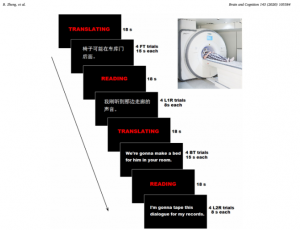Semantic and attentional networks in bilingual processing: fMRI connectivity signatures of translation directionality
Brain and Cognition
Zheng, B., Báez, S., Su, L., Xiang, X., Weis, S., Ibáñez, A. & García, A. M. (2020). Semantic and attentional networks in bilingual processing: fMRI connectivity signatures of translation directionality. Brain and Cognition 143, 105584. Online: https://bit.ly/3divdJ3
Este estudio de resonancia magnética funcional documenta patrones de conectividad funcional en bilingües durante la traducción directa (TD, de L2 a L1) e inversa (TI, de L1 a L2). En comparación con la TD, la TI arrojó mayor tasa de errores y mayor conectividad entre regiones críticas para el procesamiento semántico (lóbulo temporal anterior) y atencional (áreas frontales, prefrontales y parietales). Esto sugiere que la asimetría neurocognitiva entre la TI y la TD implica exigencias en la integración de información lingüística y atencional.
Para acceder al articulo completo hace click AQUÍ
Semantic and attentional networks in bilingual processing: fMRI connectivity signatures of translation directionality
Brain and Cognition
Zheng, B., Báez, S., Su, L., Xiang, X., Weis, S., Ibáñez, A. & García, A. M. (2020). Semantic and attentional networks in bilingual processing: fMRI connectivity signatures of translation directionality. Brain and Cognition 143, 105584. Online: https://bit.ly/3divdJ3
Comparisons between backward and forward translation (BT, FT) have long illuminated the organization of bilingual memory, with neuroscientific evidence indicating that FT would involve greater linguistic and attentional demands. However, no study has directly assessed the functional interaction between relevant mechanisms. Against this background, we conducted the first fMRI investigation of functional connectivity (FC) differences between BT and FT. In addition to yielding lower behavioral outcomes, FT was characterized by increased FC between a core semantic hub (the left anterior temporal lobe, ATL) and key nodes of attentional and vigilance networks (left inferior frontal, left orbitofrontal, and bilateral parietal clusters). Instead, distinct FC patterns for BT emerged only between the left ATL and the right thalamus, a region implicated in automatic relaying of sensory information to cortical regions. Therefore, FT seems to involve enhanced coupling between semantic and attentional mechanisms, suggesting that asymmetries in cross-language processing reflect dynamic interactions between linguistic and domain-general systems.
To access the full paper please click HERE


